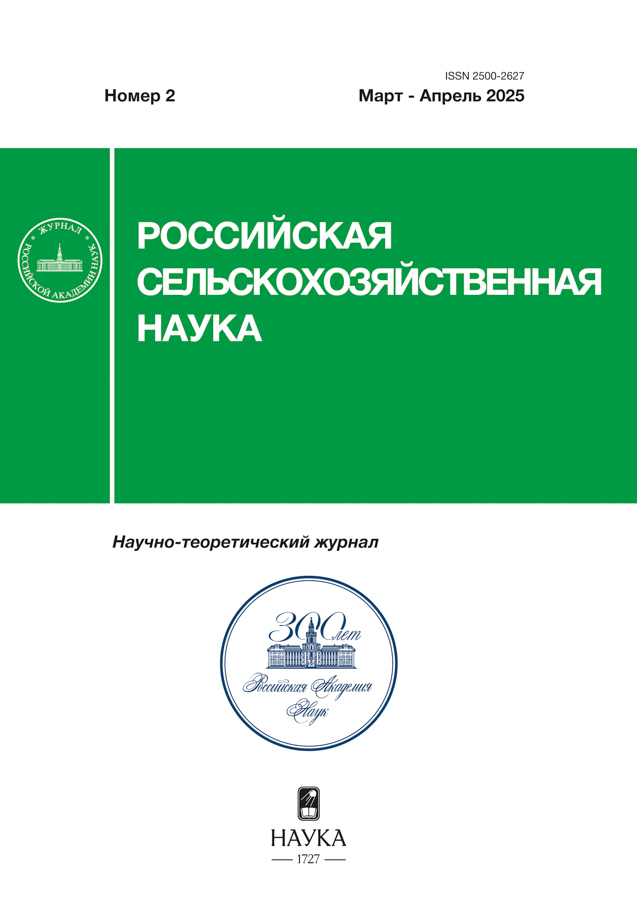Application of EPR spectrometry for identifying the irradiation of wheat seeds with low-energy electrons
- Authors: Medzhidov I.M.1, Kharlamov V.A.1, Loy N.N.1, Titova D.I.1
-
Affiliations:
- Russian Institute of Radiology and Agroecology National Research Centre «Kurchatov Institute»
- Issue: No 2 (2025)
- Pages: 67-71
- Section: Storage and processing of agricultural products
- URL: https://journals.eco-vector.com/2500-2627/article/view/684296
- DOI: https://doi.org/10.31857/S2500262725020126
- EDN: https://elibrary.ru/DFMGZH
- ID: 684296
Cite item
Abstract
The study aimed to investigate the applicability of electron paramagnetic resonance (EPR) spectrometry for detecting the radiation treatment of spring wheat seeds using low-energy electrons. Seeds of the Iren variety (2023 crop, first reproduction) were irradiated one year after harvesting with electrons at energies of 100 and 120 keV over a dose range of 1…5 kGy (step 1 kGy), dose rate was 100 Gy/imp. Non-irradiated seeds served as the control. After irradiation, the seeds were stored in the dark at room temperature and relative humidity below 60 %. EPR spectrometry was performed 14, 28 days, 3 and 6 months after irradiation. The dose dependence of the EPR signal and its attenuation over time were studied. An increase in EPR signal intensity with increasing dose was observed. The difference in signal amplitude between samples irradiated at 100 and 120 keV, depending on the dose, reached 8…55 % at day 14 and 12…62 % at day 28 (p ≤ 0,05). In the first 14–28 days, the signal decreased by 16…38 % (100 keV) and 16…32 % (120 keV), depending on the dose. After 3 months, the intensity decreased by 5…25 % (100 keV) and 5…47 % (120 keV), relative to the data of day 28. After 6 months, the signal intensity decreased by 26…33 % (100 keV) and 26…41 % (120 keV) relative to the 3-month data. The g-factor (at the zero-crossing point of the first derivative of the EPR signal) was 2.0048, confirming the presence of carbon-centred radicals.
Keywords
Full Text
About the authors
I. M. Medzhidov
Russian Institute of Radiology and Agroecology National Research Centre «Kurchatov Institute»
Author for correspondence.
Email: immedzhidov@mail.ru
Russian Federation, 249035, Kaluzhskaya obl., Obninsk, Kievskoe sh., 1, korp. 1
V. A. Kharlamov
Russian Institute of Radiology and Agroecology National Research Centre «Kurchatov Institute»
Email: immedzhidov@mail.ru
кандидат биологических наук
Russian Federation, 249035, Kaluzhskaya obl., Obninsk, Kievskoe sh., 1, korp. 1N. N. Loy
Russian Institute of Radiology and Agroecology National Research Centre «Kurchatov Institute»
Email: immedzhidov@mail.ru
кандидат биологических наук
Russian Federation, 249035, Kaluzhskaya obl., Obninsk, Kievskoe sh., 1, korp. 1D. I. Titova
Russian Institute of Radiology and Agroecology National Research Centre «Kurchatov Institute»
Email: immedzhidov@mail.ru
кандидат биологических наук
Russian Federation, 249035, Kaluzhskaya obl., Obninsk, Kievskoe sh., 1, korp. 1References
- FAO. Moving forward on food loss and waste reduction / FAO – The State of Food and Agriculture 2019. – Rome: FAO, 2019. 182 p. ISBN 978-92-5-131789-1. URL: https://openknowledge.fao.org/server/api/core/bitstreams/11f9288f-dc78-4171-8d02-92235b8d7dc7/content (дата обращения: 04.03.2025). doi: 10.4060/CA6030EN.
- Spence N., Hill L., Morris J. How the global threat of pests and diseases impacts plants, people, and the planet // Plants, People, Planet. 2020. Vol. 2. No. P. 5–13. doi: 10.1002/ppp3.10088.
- Козьмин Г. В., Гераськин С. А., Санжарова Н. И. Радиационные технологии в сельском хозяйстве и пищевой промышленности. Обнинск: ВНИИРАЭ, 2015. 400 с.
- Joint FAO/IAEA/WHO Expert Committee. Wholesomeness of irradiated food. Technical report Series 659. Geneva: World Health Organization, 1981. 34 p.
- Закладной Г. А. Радиационная дезинсекция зерна монография. М.: Центр подготовки специалистов, 2020. 150 с.
- Предпосевная обработка семян яровой пшеницы импульсным электронным пучком в атмосфере / С. Ю. Дорошкевич, К. П. Артемов, Н. Н. Терещенко и др. // Химия высоких энергий. 2021. Т. 55. № 4. С. 326–332. doi: 10.31857/S0023119321040069.
- Действие предпосевного электронного излучения на развитие проростков ячменя и активность ферментов и фитогормонов / Н. Н. Лой, Н. И. Санжарова, Е. А. Казакова и др. // Российская сельскохозяйственная наука. 2023. № 2. С. 21–24. doi: 10.31857/S2500262723020059.
- Zanardi E., Caligiani A., Novelli E. New insights to detect irradiated food: an overview // Food Analytical Methods. 2018. Vol. 11. No. 1. P. 224–235. doi: 10.1007/s12161-017-0992-1.
- Guzik G. P., Michalik J. European inter-comparison studies as a tool for perfecting irradiated food detection methods // Nukleonika. 2021. Vol. 66. No. 3. P. 91–97. doi: 10.2478/nuka-2021-0013.
- Electron paramagnetic resonance signal in wheat seeds irradiated with low-energy electron beam / R. A. Vazirov, A. A. Narkhova, E. N. Vazirova, et al. // Radiation Physics and Chemistry. 2023. Vol. 208. Article 110934. URL: https://www.sciencedirect.com/science/article/abs/pii/S0969806X23001792?via%3Dihub (дата обращения: 04.03.2025). doi: 10.1016/j.radphyschem.2023.110934.
Supplementary files











